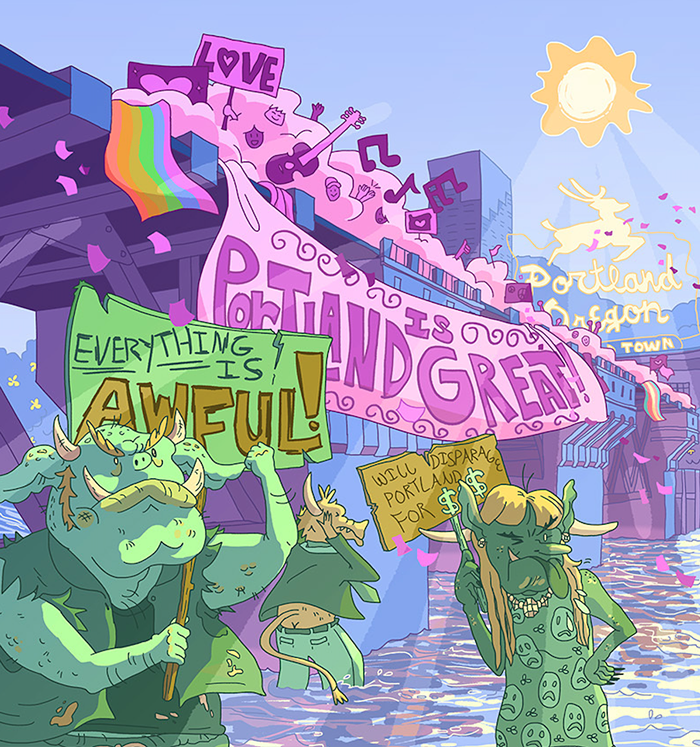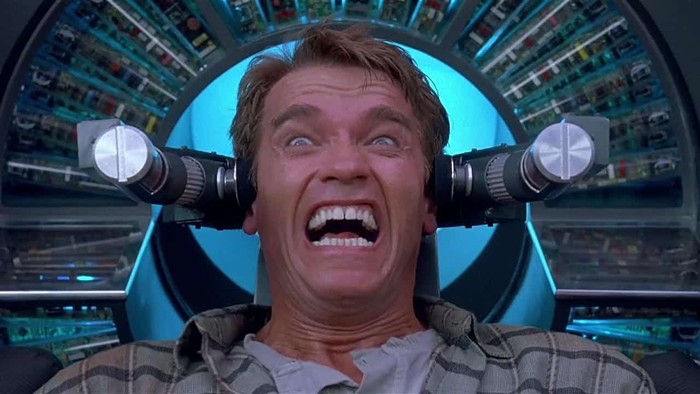Movie Madness has no center.
Portland’s largest video store and film museum doesn’t have straight, orderly aisles that herd customers toward the cash registers. In Movie Madness’ warren of hallways and shelves—with nearly every surface crammed with DVDs, VHS tapes, and Blu-rays—it’s easy to get lost. Next to a slew of Soviet-era sci-fi films stands a wall of Korean revenge thrillers. Director-specific racks hold Werner Herzog rarities and Ken Burns documentaries—mere steps away from hyper-specialized horror sections like “Killer Kids” and “Ferocious Fetuses.”
And things get weirder from there. Behind a wall of glass, a phallic monster skull from Aliens lurks, not five feet from Diane Keaton’s dress from the The Godfather: Part II. There’s the knife from Psycho’s infamous shower scene, and there are the tortoise-shell glasses Kasey Rogers wore in Strangers on a Train. There’s one of the severed ears from Blue Velvet—complete with a chunk of David Lynch’s hair.
Wandering Movie Madness evokes a feeling of endless discovery. Its massive, hodgepodge collection of movies and props celebrates film in all its forms, from classic to cult. Spending time here can also feel a bit like time-traveling: By now, the vast majority of America’s video stores have been strangled out of existence by Amazon, Hulu, and Netflix.
Even before video stores withered away, there weren’t many places like Movie Madness. Now there really aren’t many places like Movie Madness.
Luckily for Portlanders, Movie Madness is still around.
For now.

After 26 years of running Movie Madness, Mike Clark is looking to retire.
“The past few years have not been easy for the store,” admits Clark, who opened the store in 1991 on a then-sleepy stretch of Southeast Belmont. “Up until around 2012, the store had always been growing. Since then, there’s been a decline—and while not a huge decline, it’s still a decline.”
But even as Clark plans to leave his life’s work, there’s hope that Movie Madness—and its library of roughly 84,000 items—will continue. And hopefully thrive, thanks to another beloved Portland film institution: the Hollywood Theatre, the non-profit movie theater and arts organization.
There’s a catch. The Hollywood has to come up with $250,000 to purchase Clark’s collection, a sizable fee they hope to raise with an ambitious crowdfunding campaign and a series of fundraising events. (The campaign formally kicks off at the Hollywood on Wednesday, October 11, with a 35mm screening of Alfred Hitchcock’s Strangers on a Train. Clark will be in attendance—and so will Rogers’ tortoise-shell glasses.)
Should the Hollywood succeed, they’ll acquire all of Movie Madness’ films, not including those filed in the store’s porn section (a room that, thanks to the internet, has been whittled down to what Clark calls “classics” and “spoofs”), and not including Clark’s collection of props and costumes. But since Clark will continue to own Movie Madness’ building, he’s promised to continue displaying the memorabilia so long as the Hollywood retains Movie Madness’ location and name.
Another valuable aspect of the store will remain, too. Should they take over, the Hollywood plans to retain Movie Madness’ current staff—some of the city’s finest film experts, and the people who know their way around these tens of thousands of movies better than anyone else.

“Any time there’s a format jump, there are movies that are left behind,” says Dan Halsted, the Hollywood’s head programmer, whom Clark approached about the sale of Movie Madness last fall. “Netflix has like 7,000 titles and dropping. Amazon has like 20,000. Movie Madness has around 85,000 titles. You’re never going to be able to have access to most of that stuff online. There are movies that you aren’t going to be able to find anywhere else in the world that are at that store.”
The current streaming service market is typified by campaigns where services like Netflix, Hulu, and Amazon frame themselves as champions of consumer choice and accessibility. Naturally, that isn’t the full story, as streaming platforms have, in fact, drastically limited the availability of film.
Yet Movie Madness’ expansive library isn’t all that the space offers.
“Netflix has like 7,000 titles and dropping. Amazon has like 20,000. Movie Madness has around 85,000 titles. You’re never going to be able to have access to most of that stuff online. There are movies that you aren’t going to be able to find anywhere else in the world that are at that store.” —Dan Halsted, Hollywood Theatre
“What I love about watching movies is the communal aspect—seeing people walk out and talk about a film after it’s finished,” says Doug Whyte, executive director of the Hollywood. “I think the Hollywood has become a great place for that. I think the movie store can be a place too, and we want to do more of that with Movie Madness.”
Ever since Whyte joined the Hollywood in 2010, the 91-year-old theater has been transformed—in addition to world-class programming, the theater has seen the restoration of its iconic marquee, the reintroduction of 70mm film projection, and the addition of a satellite location in the Portland International Airport. But Movie Madness might be the non-profit’s most audacious project yet.
“The intention isn’t to change Movie Madness, but rather to make Mike’s astonishing collection more available to the public,” says Whyte of the Hollywood’s plans, which include everything from screening Movie Madness’ rare films on the Hollywood’s big screen to making sure Portlanders can continue to enjoy the collection from their homes.
“There’s talk of adding a screening room, hosting public events, asking people from the local film community to curate sections, having a monthly membership program,” Whyte says. “There comes the problem that some people don’t even have DVD or VHS players anymore, so we want to have them available for cheap at the store as well.”

For some elements of its crowdfunding campaign, the Hollywood’s following the lead of Scarecrow Video, Seattle’s revered video mecca. In 2014, Scarecrow ran a successful Kickstarter—raising nearly $6,000 more than their $125,000 goal—to transform itself into a non-profit and save their collection of 130,000 titles.
The shift toward a non-profit model has been gaining traction with independent rental stores, with Vidiots in Santa Monica following the same path. In addition to allowing for arts grants, going non-profit can lessen the focus on capital gains in a market monopolized by streaming. And in redefining the store’s role, Scarecrow found a second life.
“The past few years, we’ve been developing programs that allow us to get out into the community with our collection,” says Kate Barr, a board member and treasurer for Scarecrow. “We have a senior outreach program where we go out and do screenings and post-film discussions at low-income senior centers. Here at Scarecrow, we have a 'children’s hour,’ because you got to start them young. Could a for-profit store do all that? They absolutely could, but it becomes more of an imperative once you become a non-profit to be able to demonstrate how you’re serving the community.”
Barr doesn’t shy away from the challenges Scarecrow faces. Chief among them is reminding the public why collections like the ones at Scarecrow and Movie Madness still matter.
“One of the things that we’ve been doing very aggressively the past two years is going through a re-education campaign, working to show our community that movies are cultural assets,” Barr says. “Beginning in the 20th century, we started recording our cultural history in film and video. Now these [films] are our documentation of our lives in the 20th century and onward. The earliest thing [Scarecrow] has is from 1895, and the most recent thing we have is from Tuesday. And it isn’t just American-centric. We have movies from 129 countries. We estimate having over 126 different languages. You’re not going to find hardly any of that on Netflix, so this is really about the diversity of voices.”
According to Netflix tracking service Allflicks, Netflix subscribers in America currently only have access to 806 films made in other countries. Classic cinema fares even worse—as do any films not released in the past few years. Allflicks counts only 258 movies on Netflix that were made before 2000. There are only 124 films made before 1990. And if you want to watch something from before 1980, you’ve got all of 66 choices.
“Were talking about giant swaths of cinema history,” Halsted says of Movie Madness’ collection. “Pre-code movies, ’30s gangster movies, Indonesian horror movies, and ’70s Japanese biker films. You’re not going to find any of that stuff online. But it’s not just obscure stuff, [it’s] a lot of popular stuff too.”
“We’re not trying to say we’re somehow better than Netflix, Amazon, or any of the streaming services,” says Barr. “We’re not trying to say it’s either us or them. We’re trying to say there’s room for all of us.”

Looming over the Hollywood’s Kickstarter is an ominous question: If their crowdfunding campaign fails, what becomes of Movie Madness’ collection?
Marc Mohan, a film critic for the Mercury and the Oregonian, can speak from personal experience. In 2001 Mohan opened his acclaimed video store, Video Verité, on North Mississippi. Eleven years later, as rents in the gentrifying neighborhood skyrocketed, Video Verité shut its doors.
“After we closed shop, I spent weeks looking through every single title and seeing what the general price it was going for on eBay was,” Mohan says. “About 75 percent of the collection, I sold in bulk for around $1.50 a title. The remaining two or three thousand, maybe, I took home and went about selling them individually. I still have around a thousand of them in cabinets in my garage, and I continue to slowly sell them individually to private collectors. Every so often, there were DVDs I would sell for $50, $70, even $100. That said, most of it’s pennies on the dollar.”
When collections like Mohan’s are sold to collectors, there’s no turning back. The majority of those films will never be seen again, except by private collectors wealthy enough to buy rare DVDs and VHS tapes. And when film libraries are no longer available to the public, it can be devastating for entire generations of film-lovers, filmmakers, children, critics, and students—all of whom can no longer access cinema history.
Much of that history isn’t making the jump to digital. While streaming services are notoriously protective of their data, Allflicks recently found that in just two and a half years, Netflix’s film and TV offerings shrunk by a third—from 8,103 titles in 2014 to 5,532 in 2016. Consumers can now subscribe to more streaming services than ever, but those services offer increasingly fewer titles, and much of what is available represents only the most generic fare.
“There was this utopia presented to us 10 years ago,” Mohan says. “‘Soon, we will have universal access! You will be able to see any film you want to, thanks to the wonders of the internet!’ Netflix was a big part of that, and I fell for it, too. I wonder to this day if they ever really meant it, or if they had this long-term strategy in mind of killing off the competition, à la Amazon—and then being able to be, in essence, a monopoly, and not have to worry about how broad their selection was. Maybe Movie Madness is the corrective to that.”

Even as Clark prepares to hand over the keys to Movie Madness, he remains passionate about film. In 1964, at age 18, he began his career by renting out 16mm films in Portland; in the decades that followed, he worked as a film editor and post-production coordinator in Hollywood. Today, he happily walks customers and cinephiles through Movie Madness’ one-of-a-kind collection of films, memorabilia, and props. If the Hollywood succeeds in its goal to acquire and safeguard Movie Madness, Clark plans to continue his tours.
“I built this store as a place that I wanted to go to,” Clark says. “Back when I was living in Los Angeles, I used to go to four different video stores to get everything I wanted. If I wanted foreign titles, I had to go over here. If I wanted a great classic, I had to go over here. If I wanted a documentary, there was another place you had to go to!”
For now—and, hopefully, for the future—those films are all in one place.
“To me, they represent art, just like a Rembrandt painting represents art,” Clark says of the movies, props, and costumes that make up Movie Madness. “I don’t want to see the end. I don’t. I only want to see the end when I’m watching a movie. I don’t want to see the end for the store.”
For more on the Hollywood’s fundraising campaign, see hollywoodtheatre.org/moviemadness. Strangers on a Train screens Wed Oct 11 at 7 pm at the Hollywood Theatre at 4122 NE Sandy. Movie Madness is located at 4320 SE Belmont and online at moviemadnessvideo.com.



















